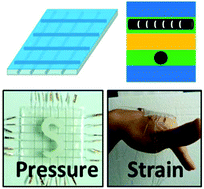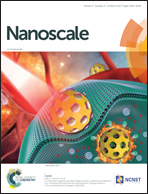Stretchable electronic skin based on silver nanowire composite fiber electrodes for sensing pressure, proximity, and multidirectional strain†
Abstract
Electronic skin (E-skin) has been attracting great research interest and effort due to its potential applications in wearable health monitoring, smart prosthetics, robot skins and so on. To expand its applications, two key challenges lie in the realization of device stretchability, and independent sensing of pressure and multidirectional lateral strain. Here we made a combination of rational device structure and artfully engineered sensing materials to fulfill the mentioned demands. The as-prepared E-skin took a simple orthogonal configuration to enable both capacitive mode for pressure sensing and resistive mode for multidirectional strain sensing, independently. Pre-cracked silver nanowire based fibers with helical microstructures were utilized as basic electrodes to endow the E-skin with intrinsic stretchability and strain sensing capability. Through dielectric layer optimization, the pressure sensing sensitivity was greatly enhanced, with a detection limit of 1.5 Pa. For application demonstrations, we utilized the E-skin as both flat and curved platforms for pressure mapping, and also as human motion sensors, such as palm and thumb bending.



 Please wait while we load your content...
Please wait while we load your content...